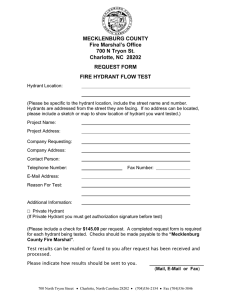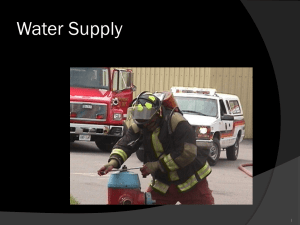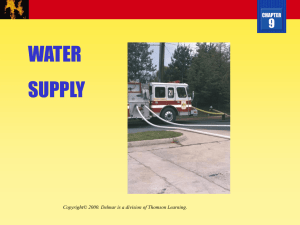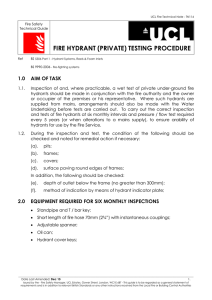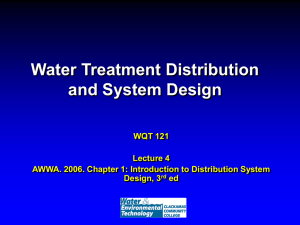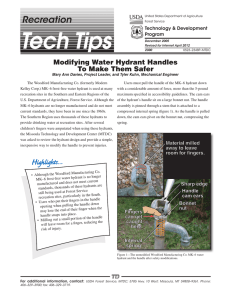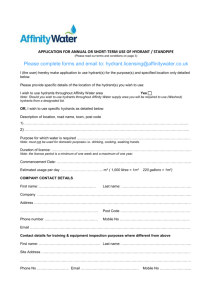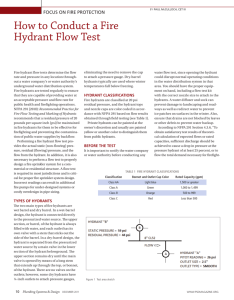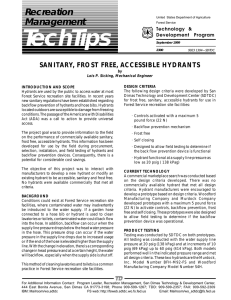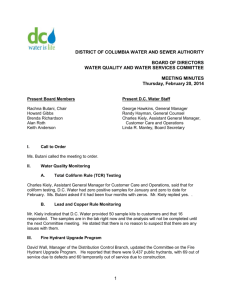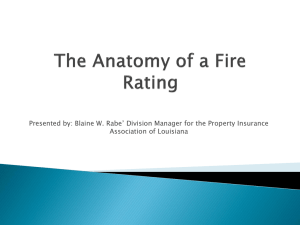Chapter 9
advertisement
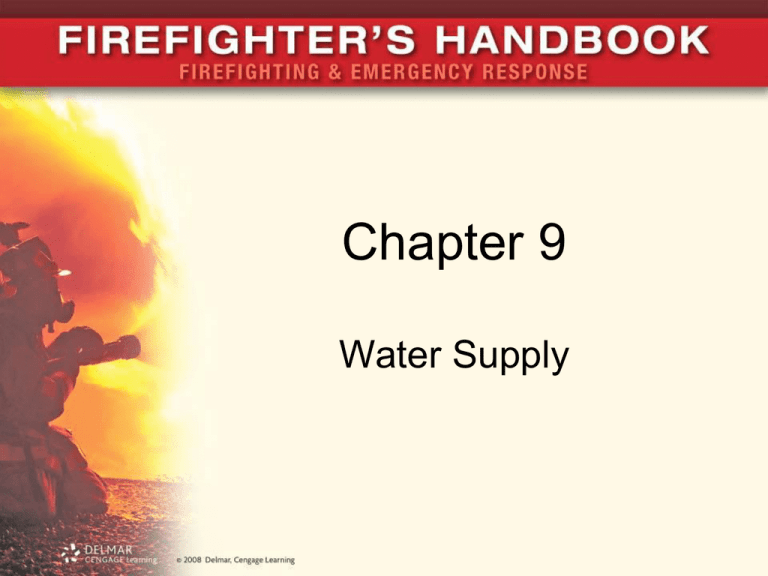
Chapter 9 Water Supply Introduction • Water supply is one of the most critical elements of firefighting • Water supply dictates the fire flow capacity • Pressure is the force of water – Measured over an area • Fire flow requirement is the amount of water required for putting out the fire • Water’s ability to absorb large quantity of heat makes it effective in fighting fire – Water cools the fuel below its ignition temperature 9.2 Sources of Water Supply • A wide range of natural and manmade factors affects water sources • Water in a constant cycle of change – Sun evaporates water into atmosphere – Condenses into clouds – Eventually falls as rain • Some areas alternate between rainy and dry seasons • Some areas have plenty of water, but it is frozen 9.3 Groundwater • Most of Earth’s freshwater supply is groundwater – Seeps into the ground from rain and other sources – Collects in aquifers – Permeates into layers of water-bearing soil • Water table: level of water under Earth’s surface • Springs are groundwater sources that flow to the surface • Shallow wells prone to changes in water table • Deep wells more predictable – Less chance of contamination 9.4 Surface Water • Almost 75 percent of the Earth covered with water – Most found in oceans and seas • Man-made surface sources include lakes, ponds, reservoirs, swimming pools, water tanks • Tidal changes are rising and falling of surface water levels – Due to gravitational effects between Earth and moon – May be as much as 40-foot difference between high and low 9.5 Mobile Water Supply Apparatus • Water tank on fire apparatus supplies the water – Small fires and fires in areas without water distribution system • Water tender: mobile water supply apparatus • Tenders combined with portable water tanks provide large volumes of water to fireground • Tenders may have small booster pump of at least 250 gpm – Fire pump of at least 750 gpm – Transfer pump of at least 250 gpm 9.6 Tanks, Ponds, and Cisterns • Water tanks may be: – Underground – Ground level – Elevated • May have a dry hydrant or other connection, or just a drafting point • Ponds may be developed for fire protection – Lined or unlined, with or without dry hydrants • Cistern: underground tank made from rock or concrete 9.7 Water Distribution Systems • Components of water distribution system: – Method of getting the water – Filtration, treatment processes – Storage, supply, and distribution • Small groundwater systems require a well with pumping station • Large well systems: multiple supply, processing, storage units with massive feeder lines • Water supplied in three ways: gravity fed, pumped, combination 9.8 (A) (B) (C) Figure 9-4 (A) Gravity-fed water distribution system. (B) A direct pump water distribution system. (C) A combination gravity-pumped water distribution system. 9.9 Fire Hydrants • Fire hydrants allow access to water supply systems • Two major hydrant types: – Wet and dry barrel hydrants • Dry hydrant: pipe system for drafting from static water source 9.10 Wet Barrel • Water in the barrel up to valves of each outlet – Used in areas not subject to freezing • Allows each outlet to be controlled by separate valve • Additional lines taken off or supplied if outlet available • Additional connection does not require flow through other outlets to be stopped • Main control valve controls flow to all outlets 9.11 Figure 9-7 Typical schematic of wet barrel hydrant. 9.12 Dry Barrel • Used in areas where freezing temperatures could damage the hydrant • Valve at base controls water flow to all outlets • Base and valve below ground at water main • Entire hydrant shut down to connect additional lines • Operation in partially open position undermines the hydrant and ground – Imminent damage to roads and buildings 9.13 Figure 9-8 Dry barrel hydrant. 9.14 Figure 9-9 Typical schematic of dry barrel hydrant. 9.15 Dry Hydrant • Not really a fire hydrant – Connection point for drafting from a static water source such as a pond or stream • Pipe system with pumper suction connection at one end and strainer at other • Primarily used in rural areas with no water distribution system • May be found in urban or suburban areas as backup water supply 9.16 Figure 9-11 Schematic of dry hydrant installation. 9.17 Specialty Hydrants • Wall hydrants mounted on wall of a building – Be sure to connect to wall hydrant and not the fire pump test connection outlet – Direct connection to water supply system • Flush-type hydrant mounted below grade level – Found in a pit, vault, or valve box – Allows access to water source where abovegrade hydrant interferes with operations • High-pressure hydrants connected to separate high-pressure water system 9.18 Figure 9-12 Wall fire hydrant. 9.19 Hydrant Protective Devices • Devices or valves designed to protect the water system • Most hydrants connected directly to domestic water supply • Many water suppliers added measures to protect water supply – Interior valves, exterior protective devices • Exterior systems require lock and key – Mostly found on privately owned property 9.20 Figure 9-13 External hydrant protective device. 9.21 Valves Associated with Water Distribution Systems • Gate valves (butterfly valves) opened and closed to control water flow – Non-indicating gate valves installed at: • Interconnections of water mains • Intermediate points of long sections of water mains • Before each hydrant and major building connection • Check valves control water flow in one direction • Backflow preventers: check valves that prevent backflow of water from one system into another 9.22 Figure 9-14 Hydrant with plumbing. Note the location of a gate valve between the water main and hydrant. 9.23 Rural Water Supply • Rural water supply can occur anywhere • Urban and suburban areas often have places where hydrants are too far away – Limited access highways, large bridges • Require careful coordination and control • Water supply group supervisor part of incident command system – Full authority over water apparatus operations • Firefighters assigned to water supply are vital 9.24 Portable Water Tanks • Mobile water supply apparatuses must quickly offload water and return to fill site • Each mobile apparatus should have a portable water tank – Capacity equal or greater than its tank size – Collapsible or inflatable tanks set up next to engine • Jet dump speeds unloading of tanks • Multiple tanks using a jet siphon set up together 9.25 Figure 9-15 Portable water tanks are an essential piece of equipment for shuttle operations. Figure 9-17 Tender at dump site dropping water directly into portable tank. 9.26 Mobile Water Apparatus Operation • Shuttle operation involves moving water between dump site and fill site • Dump site: where water delivered for quick unloading – Set up first • Fill site: location of water source – Optimum fill site allows vehicles to drive through • Shuttle operations time cannot be decreased by increased vehicle speed 9.27 Pressure Associated with Water Distribution Systems • All Earth’s water under pressure – Atmospheric pressure: 14.7 pounds per square inch • Atmospheric pressure reduces 0.5 psi per 1,000 feet of elevation • Pressure in non-flowing closed system equal at all points – While flowing, reduced by friction and loss of pressure at opening 9.28 Pressure Associated with Water Distribution Systems (cont’d.) • Distribution systems supplied under pressure – System pressure never as high as firefighters prefer • Pressures below recommended low residual pressure create a vacuum in part of the supply • High-flow and/or high-pressure areas are an advantage – Low-flow and/or low-pressure areas should be 9.29 avoided Figure 9-21 Atmospheric pressure being exerted on container of water. 9.30 Figure 9-22 Pressure is expressed in pounds per unit area (psi). 9.31 Testing Operability and Flow of Hydrants • Regular testing identifies inadequate hydrants – Coordinated between fire and water departments • Operability testing: – Wet and dry hydrants: • Visual inspection for damage • Ensuring hydrant valve closed • Remove all caps, check threads and gaskets • Check that all valves allow water to flow 9.32 Testing Operability and Flow of Hydrants (cont’d.) • Operability testing (cont’d.): – Dry barrel hydrant: • Ensure drain valve working • Determine water level dropping after hydrant shut off • Visual inspection of piping, caps, gaskets • Flow test followed by backflushing of the hydrant – Replace caps, oil moving parts, and paint the hydrant • Fireground method for flow tests 9.33 Determining Static, Residual, and Flow Pressures • Connect a pumper to a hydrant and turn it on • Static pressure: pressure in the system with no hydrants or water flowing • Charge the first line with desired volume – Check compound gauge for residual pressure – Compare percentage of pressure drop from static to residual • Second test involves multiple hydrants – Not conducted during fire operations 9.34 Table 9-1 Percentage Drop Measurements 9.35 Obstructions and Damage to Fire Hydrants and Mains • Obstructions and damage can occur to fire hydrants and water mains – Small leaks develop as water system matures – Vandals damage by opening or closing valves – Opening valve in freezing weather without allowing water to flow may cause hydrant to freeze and crack – Accidents can crack pipes or break off a hydrant • Firefighters should ensure hydrant is opened or closed fully 9.36 Lessons Learned • Water is the most common fire extinguishing agent – Must be supplied in sufficient quantity • Supplying water requires understanding of the water source and the valves and hydrants • In areas with no distribution system, create one • Difficult to sustain adequate fire flow with mobile apparatus 9.37
